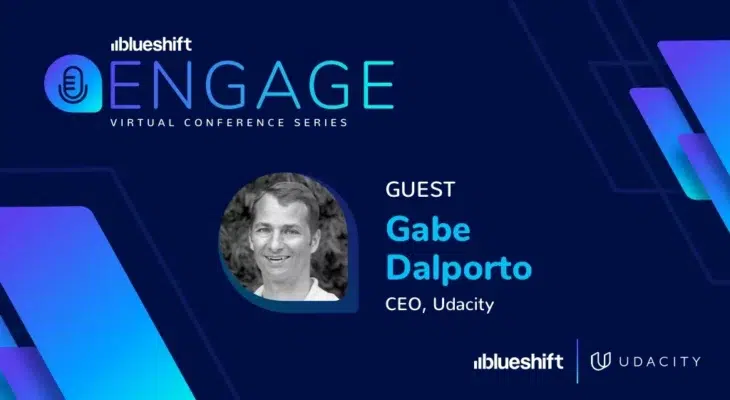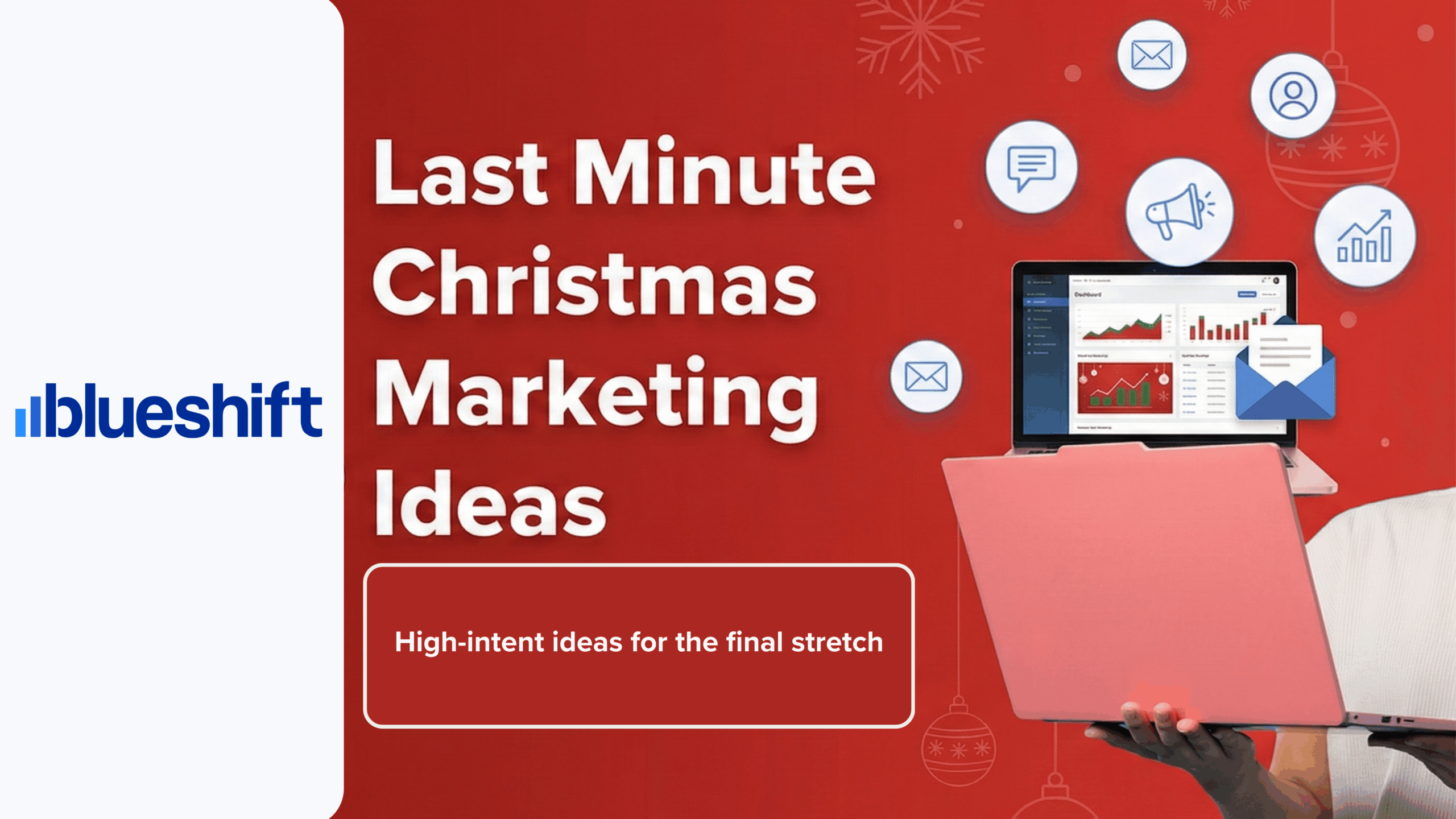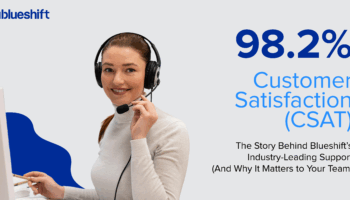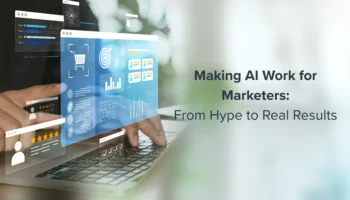Marketers, business leaders, and Blueshift users have come together for our first-ever virtual conference: Blueshift Engage. For one hour each day, we’ve brought the brightest minds in marketing to our attendees — live from their living rooms. We know marketers are busy folks, so we’ve taken our live sessions and picked out the best bits for your reading pleasure. For our third day, Blueshift’s CEO, Vijay Chittoor, sat down with Gabriel Dalporto, CEO of Udacity to discuss ways the COVID-19 situation changes long-term business strategies and how marketers and business leaders can position themselves for long-term success by applying a learning mindset to uncertainty.
Blueshift Engage: Being Adaptive and Embracing the Learning Mindset

VIJAY: COULD YOU TELL US A LITTLE BIT ABOUT UDACITY AND YOUR MISSION?
Gabe: So the mission of Udacity is to really upskill the world’s workers on the careers of the future. What we do is hyper-relevant because the World Economic Forum, before COVID-19, predicted a billion people are going to lose their jobs due to AI and machine learning or technology automation. And that’s not just going to be blue-collar workers, it’s going to be everybody. In fact, AI can often detect cancer in an x-ray better than a doctor can now, so everybody’s jobs can be affected or disrupted in some way. We as a company have stepped in to fill the education gap and provide workers with real skills they can take into the workforce.
That’s personally important to me because I grew up in West Virginia, wherein my childhood there existed a vibrant economy. Most people in that area had coal mining jobs and as those jobs become replaced with automation, entire communities were brought to their knees. Unfortunately, West Virginia did not upskill their workers and so most people, if they have a job, are making barely subsistence wages. So to me, it’s a very personal mission, “How do we solve this problem that started in maybe Appalachia and the Rust Belt, but is rapidly expanding across the globe as industries are disrupted and workers upskill?”
VIJAY: YOU ARE A NUCLEAR ENGINEERING GRADUATE AND M.I.T. GRADUATE — HOW DOES SOMEONE LIKE YOU END UP IN MARKETING IN THE FIRST PLACE?
Gabe: I don’t know! I think it was in 2000, right before the stock market crash and I was working as a nuclear engineer, but then had found my way into strategy consulting and loved it. But, strategy can be a little bit hollow. So I thought, “what would I like to do?”. I ran from cold, data-driven, and analytical engineering to its complete opposite: marketing, which is instead driven by consumer psychology and emotion.
To me, that was a way to really push myself. With marketing, it was interesting how nuclear engineering skills extended themselves. So I think any job functions like engineering, is just a problem to be solved. Luckily, I kind of found my way into marketing, which is very much just test and learn, data and analytics, and the testing of hypotheses. I learned really neat things about how people respond to different pricing structures and how they respond to different co-branding opportunities. That gave me a sense of what drives consumers and I was able to then move into digital marketing, and ultimately into brand marketing. One interesting anecdote is that at some point I figured out that the math behind multi-level marketing was not too dissimilar from the math behind a nuclear reactor!
VIJAY: HOW IS THE MARKETER’S ROLE SHIFTING INTO A MORE DATA-DRIVEN ONE? WHAT IS YOUR ADVICE ON WHAT MARKETERS SHOULD BE DOING TO SHAPE THEIR CAREER?
Gabe: I cannot emphasize enough how important analytics will become a part of the marketing role. Direct mail bank marketers realized early on that you could build predictive logistic response models to predict which individuals would be more likely to respond. That basic approach has moved onto the digital world where you can track individual behaviors, conversion rates, LTVs, etc. The math behind marketing has gotten progressively more sophisticated and the trends that are affecting jobs, in general, will affect your job.
So, you need to think what’s your next value add? How do you enrich your skillset to maintain your relevance? The world is shifting to be more digital and more analytics-driven — marketers are just going to need to be savvier there.
VIJAY: YOU’VE LIVED THROUGH RECESSIONS, WHICH IMPACTED JUST AS MUCH AS COVID-19 HAS. HOW HAVE YOU SEEN BUSINESSES ADAPT IN DOWNTURNS? WHAT HAVE BUSINESS LEADERS DONE TO COME OUT STRONGER ON THE OTHER END? AND HOW DOES A TEAM WITH THAT “LEARNING AND ADAPTABILITY MENTALITY” PLAY INTO THAT?
Gabe: I think the important learning from big disruptions like this is it causes lasting changes and innovation. The Expedia’s of the world came into mainstream after the 2001 crash when the large airline and hospitality chains needed them. A lot of innovation happened after the dot com crash and the 2008 recession. And frankly, I don’t think we’ve even scratched the surface of the impact COVID-19 will have comparatively. In times of crisis, doors will open and doors will close. Marketers need to keep their ears to the ground and sprint for the doors that are opening right now.
In March, Udacity as a company took stock of how the job market was changing and we said, “Let’s put on our empathy hats — let’s put ourselves in the shoes of these people who just lost their jobs. What do they need right now?”. That has changed how we were going to market with our consumer product. So we opened up our platform for the entire month of April and made it free and saw something like a 20x increase in platform users. Many of them continued through the paid platform. So, it was a win for us financially and it was a win for the students who were getting skills for free. It’s important to realize the situation that you’re in and take risks — that’s what breeds innovation.
VIJAY: HOW DID YOU GET UDACITY READY TO ADAPT TO A CHANGING LANDSCAPE WHEN YOU HAD NO IDEA ALL OF THIS WAS COMING?
Gabe: I joined back in August and I was very fortunate that my predecessors had built a really great product — it transforms lives and careers. But, we weren’t executing that well. One of the fundamental things I saw was a lack of data-driven, fact-based, decision making. Historically, a lot of decisions were made in a vacuum without a ton of data to support it. And so one of the first things I did was create a culture of making decisions based on data and facts.
One of the first opportunities I got to prove this theory was at an All Hands. I said, “I had a hypothesis about how we should adjust messaging around our Mentor Review (which is essentially a network of tutors) because I thought no one knew what we meant. So we ran an A/B test. Turns out I was wrong. I admitted to my company that data wins and your CEO loses”. The foundation is building a culture of rapid iteration, rapid test, and learning. Once you have that motion going, it’s a lot easier to throw in a disruptive idea. This might be shocking to companies that are living in the qualitative world of the past and not living in the data-driven world of the future.
VIJAY: THE ROLE YOU TOOK ON AFTER BEING THE CMO AT LENDING TREE WAS THE CFO AT LENDING TREE. HOW DID THAT COME ABOUT AND HOW DID YOU PREPARE YOURSELF TO MAKE THAT TRANSITION?
Gabe: Well, one Friday night, I got a call from our CEO asking for me to step into the CFO role. It was a total shock to me. My CEO explained he needed someone who knows the business inside out, who can be a strategic CFO, and who can drive the business using data and analytics. I thought, “OK, I think I can do that, but I have a lot to learn.”
It goes back to my engineering roots of understanding what the basic functions of CFO are: investor relations, capital raising, financial planning, analysis, and accounting. So I took each of those functions, broke them down, and made sure I had great people leading those areas. I was never going to be an expert in accounting — I made sure I had a really, really talented person in accounting.
And then I thought about investor relations as sales and marketing. IR is like telling a story to investors and helping them understand the value company. So that was pretty straightforward. I put on my strategy hat from my consulting days. And I said, “what do we need to change to accelerate the business?” We needed to raise money. So, we went out and raised four million dollars and then we used that to buy companies.
It was very, very uncomfortable in that learning phase. But, if you systematically think about a problem and you break it down into a job role and job skills, you can learn that new job in about four to six months and you can get really good at it in about a year.
VIJAY: WHAT ARE SOME PIECES OF CAREER ADVICE YOU WOULD GIVE TO A 30-YEAR-OLD YOU?
Gabe: Be very ambitious and driven and have very high expectations for yourself. I think I did that well because, at 30, I didn’t need my boss to criticize me because I was criticizing myself all the time. If you’re not getting better every day, then you’re stagnating.
Number two, this is a key piece of advice I give to everybody that I mentor. Anytime there is a big problem without a clear owner, ask for the ball and run with it. Special projects are amazing — most times there will be a company that wants to do something, but there’s no owner because it’s a new initiative. Just take it and run with it and take initiative — and by God, deliver on it.
I’m also very analytical and structured about how I approach problems. I just thought of every challenge as if I didn’t know one thing about it, I figured I could break it down and figure out what the drivers are and solve it. But what I really struggled with was people. It’s ok to “just be good” at your job — until you reach the director level. When I got to that level, my boss loved me, my subordinates loved me, and my peers hated me. I was perfectly nice to my coworkers, but I wasn’t great at involving them in the process. I liked tackling problems anytime I saw one, even if it wasn’t my job. I’d say, “Oh hey, here’s a solution” and thought they’d be happy because I found the answer. Nope. They’d get mad and wonder why I was encroaching. I realized if I want to be successful, I need really strong peer relationships.
VIJAY: HOW HAS THE COVID-19 SITUATION CHANGED THE WORLD OF LEARNING AND EDUCATION?
Gabe: Arguably the only good to come out of this horrible, horrible disease is that it has pushed online learning forward 10 years, overnight. The days of in-person, expensive employee training and student education are over — that won’t be happening at all for the next 12 months and business will have to adjust. Universities have been very slow to adopt online learning. And then all of a sudden, every university in the world has to go online and by and large, doing it terribly.
Online learning is going to go through a sea change and this is a very powerful time for players like Udacity. The Wall Street Journal just had an article a couple of days ago about how universities are expecting a $44 billion revenue shortfall this year and next year will be difficult with students opting out of dorms. This is going to put a lot of universities out of business and it’s going to shift the ways universities think about their business and their preparedness to deliver online.
It’s a hard pill to swallow. I’m the benefit of a beneficiary of great university education. But, since the 80s, the rate of tuition increase has far outpaced inflation — that’s not sustainable. Universities have to think of themselves as a business, have a good value proposition, and reasonable pricing. I think the big trend here is the realization that learning is lifelong. Universities do a good job of taking kids and teaching them how to think critically. They don’t necessarily do a good job of graduating people with real skillsets. COVID-19 is going to force a shift into more career-oriented education.
AUDIENCE QUESTION: WHAT BLUESHIFT TECHNOLOGY HAS BEEN MOST BENEFICIAL FOR YOU AT UDACITY AND LENDING TREE?
Gabe: My eyes opened to Blueshift when Josh Francia (now the Chief Growth Officer of Blueshift) was running CRM for LendingTree. At the time we were delivering some basic CRM campaigns. We had a data science group that was building one-off models and the process was painful and slow. But in contrast, the Blueshift platform is just so easy to use and to apply machine learning algorithms. And that was really our first move into the mass application of machine learning algorithms. Our CRM efforts were up by 40X. It really started our journey with delivering hyper-targeted and automated messaging so I think the custom AI is what really stuck out to me.
FINAL THOUGHTS
To wrap up this session, let’s highlight a great positive moment from today, “Doors will open and doors will close. Marketers need to keep their ears to the ground and sprint for the doors that are opening right now.” It’s all about becoming prepared as an individual, and a company, to be able to run to those opening doors as quickly as possible and having the ability to be comfortable with trying new things, “raising your hand”, and leveraging great resources like Udacity to upskill yourself constantly.


